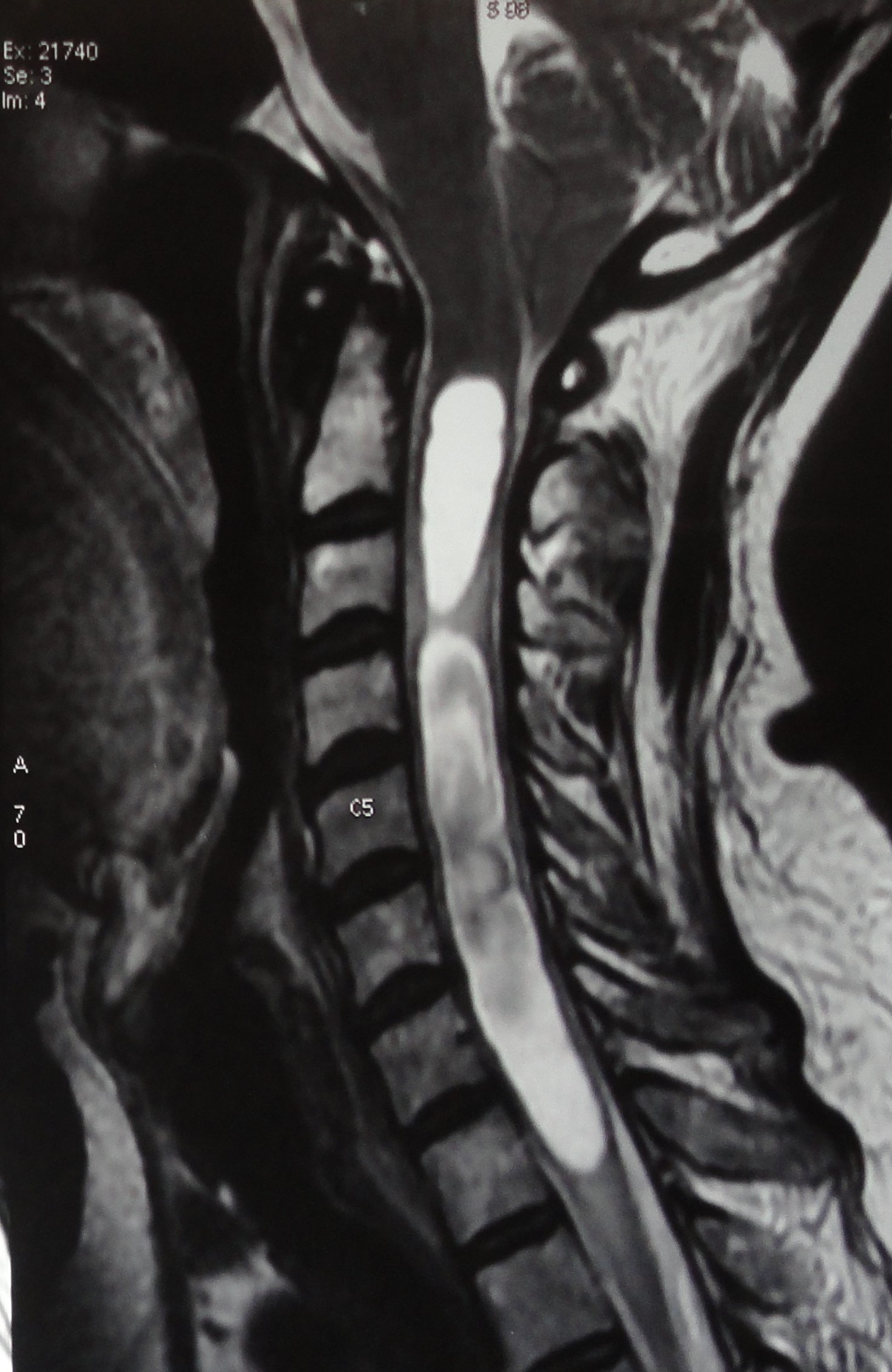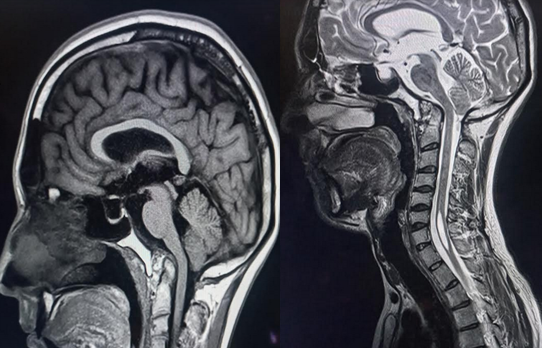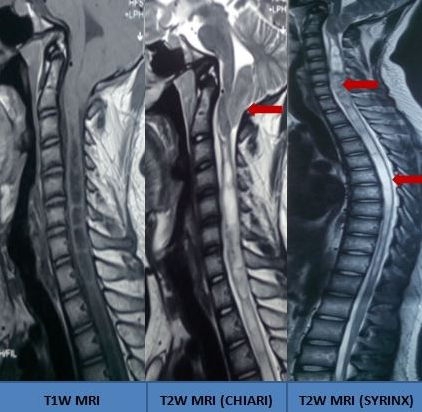[1]
Roy AK, Slimack NP, Ganju A. Idiopathic syringomyelia: retrospective case series, comprehensive review, and update on management. Neurosurgical focus. 2011 Dec:31(6):E15. doi: 10.3171/2011.9.FOCUS11198. Epub
[PubMed PMID: 22133183]
Level 2 (mid-level) evidence
[2]
Klekamp J, Batzdorf U, Samii M, Bothe HW. Treatment of syringomyelia associated with arachnoid scarring caused by arachnoiditis or trauma. Journal of neurosurgery. 1997 Feb:86(2):233-40
[PubMed PMID: 9010425]
[3]
Greitz D. Unraveling the riddle of syringomyelia. Neurosurgical review. 2006 Oct:29(4):251-63; discussion 264
[PubMed PMID: 16752160]
[4]
Roser F, Ebner FH, Sixt C, Hagen JM, Tatagiba MS. Defining the line between hydromyelia and syringomyelia. A differentiation is possible based on electrophysiological and magnetic resonance imaging studies. Acta neurochirurgica. 2010 Feb:152(2):213-9; discussion 219. doi: 10.1007/s00701-009-0427-x. Epub 2009 Jun 16
[PubMed PMID: 19533016]
[5]
Bogdanov EI, Mendelevich EG. Syrinx size and duration of symptoms predict the pace of progressive myelopathy: retrospective analysis of 103 unoperated cases with craniocervical junction malformations and syringomyelia. Clinical neurology and neurosurgery. 2002 May:104(2):90-7
[PubMed PMID: 11932037]
Level 2 (mid-level) evidence
[6]
Milhorat TH, Chou MW, Trinidad EM, Kula RW, Mandell M, Wolpert C, Speer MC. Chiari I malformation redefined: clinical and radiographic findings for 364 symptomatic patients. Neurosurgery. 1999 May:44(5):1005-17
[PubMed PMID: 10232534]
[7]
Mampalam TJ, Andrews BT, Gelb D, Ferriero D, Pitts LH. Presentation of type I Chiari malformation after head trauma. Neurosurgery. 1988 Dec:23(6):760-2
[PubMed PMID: 3216976]
[9]
Zuev AA, Kostenko GV. [Treatment of syringomyelia associated with Chiari 1 malformation]. Zhurnal nevrologii i psikhiatrii imeni S.S. Korsakova. 2017:117(3):102-106. doi: 10.17116/jnevro201711731102-106. Epub
[PubMed PMID: 28399105]
[10]
Zheng YC, Liu YT, Wei KC, Huang YC, Chen PY, Hsu YH, Lin CL. Outcome predictors and clinical presentation of syringomyelia. Asian journal of surgery. 2023 Feb:46(2):705-711. doi: 10.1016/j.asjsur.2022.06.150. Epub 2022 Jul 20
[PubMed PMID: 35868963]
[11]
Milhorat TH, Capocelli AL Jr, Anzil AP, Kotzen RM, Milhorat RH. Pathological basis of spinal cord cavitation in syringomyelia: analysis of 105 autopsy cases. Journal of neurosurgery. 1995 May:82(5):802-12
[PubMed PMID: 7714606]
Level 3 (low-level) evidence
[12]
Ciaramitaro P, Garbossa D, Peretta P, Piatelli G, Massimi L, Valentini L, Migliaretti G, Baldovino S, Roccatello D, Kodra Y, Taruscio D, Interregional Chiari and Syringomyelia Consortium, on behalf of the Interregional Chiari and Syringomyelia Consortium. Syringomyelia and Chiari Syndrome Registry: advances in epidemiology, clinical phenotypes and natural history based on a North Western Italy cohort. Annali dell'Istituto superiore di sanita. 2020 Jan-Mar:56(1):48-58. doi: 10.4415/ANN_20_01_08. Epub
[PubMed PMID: 32242535]
Level 3 (low-level) evidence
[13]
Yuan C, Guan J, Du Y, Fang Z, Wang X, Yao Q, Zhang C, Liu Z, Wang K, Duan W, Wang X, Wang Z, Wu H, Jian F. Neurological deterioration after posterior fossa decompression for adult syringomyelia: Proposal for a summarized treatment algorithm. Frontiers in surgery. 2022:9():968906. doi: 10.3389/fsurg.2022.968906. Epub 2022 Sep 15
[PubMed PMID: 36189393]
[14]
Gade SP, Harjpal P, Kovela RK. Novelty in Impact of Neurorehabilitation in a Classic Case of Syringomyelia. Cureus. 2022 Sep:14(9):e29126. doi: 10.7759/cureus.29126. Epub 2022 Sep 13
[PubMed PMID: 36258946]
Level 3 (low-level) evidence
[15]
Thi Phuong Dinh H, Tomohiko H, Madelar RT, Dinh Anh Hoang H, Yukihiro M. Giant-Cell Ependymoma of the Cervical Spinal Cord With Syringomyelia and Pathological Presentation: A Case Report and Review of the Literature. Cureus. 2022 Dec:14(12):e33174. doi: 10.7759/cureus.33174. Epub 2022 Dec 31
[PubMed PMID: 36726917]
Level 3 (low-level) evidence
[16]
How Hong EA, Shalid A, Deepak S, Kounin G. Posterior Cranial Fossa Meningioma Causing Tonsillar Herniation and Giant Cervicothoracic Syringomyelia: Case Report and Review of Literature. Asian journal of neurosurgery. 2022 Sep:17(3):515-520. doi: 10.1055/s-0042-1756634. Epub 2022 Oct 8
[PubMed PMID: 36398186]
Level 3 (low-level) evidence
[17]
Guan J, Yuan C, Zhang C, Ma L, Yao Q, Cheng L, Liu Z, Wang K, Duan W, Wang X, Wu H, Chen Z, Jian F. Intradural Pathology Causing Cerebrospinal Fluid Obstruction in Syringomyelia and Effectiveness of Foramen Magnum and Foramen of Magendie Dredging Treatment. World neurosurgery. 2020 Dec:144():e178-e188. doi: 10.1016/j.wneu.2020.08.068. Epub 2020 Aug 15
[PubMed PMID: 32805463]
[18]
Shao B, Wojcik D, Ma KL, Amaral-Nieves N, Poggi JA, Leary OP, Klinge PM. Reappraisal of intradural findings in Chiari malformation type I. Neurosurgical focus. 2023 Mar:54(3):E2. doi: 10.3171/2022.12.FOCUS22628. Epub
[PubMed PMID: 36857788]
[19]
Arnautovic A, Splavski B, Boop FA, Arnautovic KI. Pediatric and adult Chiari malformation Type I surgical series 1965-2013: a review of demographics, operative treatment, and outcomes. Journal of neurosurgery. Pediatrics. 2015 Feb:15(2):161-77. doi: 10.3171/2014.10.PEDS14295. Epub 2014 Dec 5
[PubMed PMID: 25479580]
[20]
Holste KG, Muraszko KM, Maher CO. Epidemiology of Chiari I Malformation and Syringomyelia. Neurosurgery clinics of North America. 2023 Jan:34(1):9-15. doi: 10.1016/j.nec.2022.08.001. Epub 2022 Nov 3
[PubMed PMID: 36424068]
[21]
GARDNER WJ, ANGEL J. The mechanism of syringomyelia and its surgical correction. Clinical neurosurgery. 1958:6():131-40
[PubMed PMID: 13826542]
[23]
Williams B. On the pathogenesis of syringomyelia: a review. Journal of the Royal Society of Medicine. 1980 Nov:73(11):798-806
[PubMed PMID: 7017117]
[24]
Oldfield EH, Muraszko K, Shawker TH, Patronas NJ. Pathophysiology of syringomyelia associated with Chiari I malformation of the cerebellar tonsils. Implications for diagnosis and treatment. Journal of neurosurgery. 1994 Jan:80(1):3-15
[PubMed PMID: 8271018]
[25]
Milhorat TH, Miller JI, Johnson WD, Adler DE, Heger IM. Anatomical basis of syringomyelia occurring with hindbrain lesions. Neurosurgery. 1993 May:32(5):748-54; discussion 754
[PubMed PMID: 8492850]
[26]
Ball MJ, Dayan AD. Pathogenesis of syringomyelia. Lancet (London, England). 1972 Oct 14:2(7781):799-801
[PubMed PMID: 4116236]
[27]
Oldfield EH. Pathogenesis of Chiari I - Pathophysiology of Syringomyelia: Implications for Therapy: A Summary of 3 Decades of Clinical Research. Neurosurgery. 2017 Sep 1:64(CN_suppl_1):66-77. doi: 10.1093/neuros/nyx377. Epub
[PubMed PMID: 28899066]
[28]
Koyanagi I, Houkin K. Pathogenesis of syringomyelia associated with Chiari type 1 malformation: review of evidences and proposal of a new hypothesis. Neurosurgical review. 2010 Jul:33(3):271-84; discussion 284-5. doi: 10.1007/s10143-010-0266-5. Epub 2010 Jun 8
[PubMed PMID: 20532585]
[29]
Honey CM, Martin KW, Heran MKS. Syringomyelia Fluid Dynamics and Cord Motion Revealed by Serendipitous Null Point Artifacts during Cine MRI. AJNR. American journal of neuroradiology. 2017 Sep:38(9):1845-1847. doi: 10.3174/ajnr.A5328. Epub 2017 Jul 27
[PubMed PMID: 28751514]
[30]
Van Der Veken J, Harding M, Hatami S, Agzarian M, Vrodos N. Syringomyelia intermittens: highlighting the complex pathophysiology of syringomyelia. Illustrative case. Journal of neurosurgery. Case lessons. 2021 Sep 13:2(11):CASE21341. doi: 10.3171/CASE21341. Epub 2021 Sep 13
[PubMed PMID: 35855301]
Level 3 (low-level) evidence
[31]
Wang X, Jiang C, Lu C, Ma L, Feng Y, Cui S, Li Q, Li K, Wang X, Jian F. Impairment of Connexin 43 may initiate cilia decline in syringomyelia. Experimental neurology. 2023 Jul:365():114430. doi: 10.1016/j.expneurol.2023.114430. Epub 2023 Apr 28
[PubMed PMID: 37121428]
[32]
Halvorson KG, Kellogg RT, Keachie KN, Grant GA, Muh CR, Waldau B. Morphometric Analysis of Predictors of Cervical Syrinx Formation in the Setting of Chiari I Malformation. Pediatric neurosurgery. 2016:51(3):137-41. doi: 10.1159/000442991. Epub 2016 Feb 13
[PubMed PMID: 26871424]
[33]
Wang S, Zhang D, Wu K, Fan W, Fan T. Potential association among posterior fossa bony volume and crowdedness, tonsillar hernia, syringomyelia, and CSF dynamics at the craniocervical junction in Chiari malformation type I. Frontiers in neurology. 2023:14():1069861. doi: 10.3389/fneur.2023.1069861. Epub 2023 Feb 20
[PubMed PMID: 36891476]
[34]
Clarke EC, Stoodley MA, Bilston LE. Changes in temporal flow characteristics of CSF in Chiari malformation Type I with and without syringomyelia: implications for theory of syrinx development. Journal of neurosurgery. 2013 May:118(5):1135-40. doi: 10.3171/2013.2.JNS12759. Epub 2013 Mar 15
[PubMed PMID: 23495878]
[35]
Weig SG, Buckthal PE, Choi SK, Zellem RT. Recurrent syncope as the presenting symptom of Arnold-Chiari malformation. Neurology. 1991 Oct:41(10):1673-4
[PubMed PMID: 1922816]
[36]
Batzdorf U, Khoo LT, McArthur DL. Observations on spine deformity and syringomyelia. Neurosurgery. 2007 Aug:61(2):370-7; discussion 377-8
[PubMed PMID: 17762750]
[37]
Milhorat TH, Mu HT, LaMotte CC, Milhorat AT. Distribution of substance P in the spinal cord of patients with syringomyelia. Journal of neurosurgery. 1996 Jun:84(6):992-8
[PubMed PMID: 8847594]
[38]
Grant R, Hadley DM, Macpherson P, Condon B, Patterson J, Bone I, Teasdale GN. Syringomyelia: cyst measurement by magnetic resonance imaging and comparison with symptoms, signs and disability. Journal of neurology, neurosurgery, and psychiatry. 1987 Aug:50(8):1008-14
[PubMed PMID: 3655805]
[39]
Fujii K, Natori Y, Nakagaki H, Fukui M. Management of syringomyelia associated with Chiari malformation: comparative study of syrinx size and symptoms by magnetic resonance imaging. Surgical neurology. 1991 Oct:36(4):281-5
[PubMed PMID: 1948628]
Level 2 (mid-level) evidence
[40]
Goel A, Desai K. Surgery for syringomyelia: an analysis based on 163 surgical cases. Acta neurochirurgica. 2000:142(3):293-301; discussion 301-2
[PubMed PMID: 10819260]
Level 3 (low-level) evidence
[41]
Brodbelt AR, Stoodley MA. Post-traumatic syringomyelia: a review. Journal of clinical neuroscience : official journal of the Neurosurgical Society of Australasia. 2003 Jul:10(4):401-8
[PubMed PMID: 12852875]
[42]
Mariani C, Cislaghi MG, Barbieri S, Filizzolo F, Di Palma F, Farina E, D'Aliberti G, Scarlato G. The natural history and results of surgery in 50 cases of syringomyelia. Journal of neurology. 1991 Dec:238(8):433-8
[PubMed PMID: 1779249]
Level 3 (low-level) evidence
[43]
Mauer UM, Freude G, Danz B, Kunz U. Cardiac-gated phase-contrast magnetic resonance imaging of cerebrospinal fluid flow in the diagnosis of idiopathic syringomyelia. Neurosurgery. 2008 Dec:63(6):1139-44; discussion 1144. doi: 10.1227/01.NEU.0000334411.93870.45. Epub
[PubMed PMID: 19057326]
[44]
Lu C, Ma L, Yuan C, Cheng L, Wang X, Duan W, Wang K, Chen Z, Wu H, Zeng G, Jian F. Phenotypes and Prognostic Factors of Syringomyelia in Single-Center Patients With Chiari I Malformation: Moniliform Type as a Special Configuration. Neurospine. 2022 Sep:19(3):816-827. doi: 10.14245/ns.2244332.166. Epub 2022 Sep 30
[PubMed PMID: 36203304]
[45]
Dyste GN, Menezes AH, VanGilder JC. Symptomatic Chiari malformations. An analysis of presentation, management, and long-term outcome. Journal of neurosurgery. 1989 Aug:71(2):159-68
[PubMed PMID: 2746341]
[46]
Attal N, Parker F, Tadié M, Aghakani N, Bouhassira D. Effects of surgery on the sensory deficits of syringomyelia and predictors of outcome: a long term prospective study. Journal of neurology, neurosurgery, and psychiatry. 2004 Jul:75(7):1025-30
[PubMed PMID: 15201364]
[47]
Lee TT, Alameda GJ, Camilo E, Green BA. Surgical treatment of post-traumatic myelopathy associated with syringomyelia. Spine. 2001 Dec 15:26(24 Suppl):S119-27
[PubMed PMID: 11805618]
[48]
Hida K, Iwasaki Y, Koyanagi I, Sawamura Y, Abe H. Surgical indication and results of foramen magnum decompression versus syringosubarachnoid shunting for syringomyelia associated with Chiari I malformation. Neurosurgery. 1995 Oct:37(4):673-8; discussion 678-9
[PubMed PMID: 8559295]
[49]
Grant R, Hadley DM, Lang D, Condon B, Johnston R, Bone I, Teasdale GM. MRI measurement of syrinx size before and after operation. Journal of neurology, neurosurgery, and psychiatry. 1987 Dec:50(12):1685-7
[PubMed PMID: 3437304]
[50]
Goel A. Scoliosis and Syringomyelia. Neurology India. 2022 Sep-Oct:70(5):2192-2193. doi: 10.4103/0028-3886.359263. Epub
[PubMed PMID: 36352639]
[51]
Frič R, Ringstad G, Eide PK. Low versus High Intracranial Compliance in Adult Patients with Chiari Malformation Type 1-Comparison of Long-Term Outcome After Tailored Treatment. World neurosurgery. 2023 May:173():e699-e707. doi: 10.1016/j.wneu.2023.02.134. Epub 2023 Mar 6
[PubMed PMID: 36889634]
[52]
Spennato P, Vitulli F, Tafuto R, Imperato A, Mirone G, Cinalli G. Fourth ventricle to spinal subarachnoid space stenting in pediatric patients with refractory syringomyelia: case series and systematic review. Neurosurgical review. 2023 Mar 11:46(1):67. doi: 10.1007/s10143-023-01972-y. Epub 2023 Mar 11
[PubMed PMID: 36905420]
Level 1 (high-level) evidence
[53]
Han RK, Medina MP, Giantini-Larsen AM, Chae JK, Cruz A, Garton ALA, Greenfield JP. Fourth ventricular subarachnoid stent for Chiari malformation type I-associated persistent syringomyelia. Neurosurgical focus. 2023 Mar:54(3):E10. doi: 10.3171/2022.12.FOCUS22633. Epub
[PubMed PMID: 36857783]
[54]
Logue V, Edwards MR. Syringomyelia and its surgical treatment--an analysis of 75 patients. Journal of neurology, neurosurgery, and psychiatry. 1981 Apr:44(4):273-84
[PubMed PMID: 7241155]
[55]
Deng X, Yang C, Gan J, Wu L, Yang T, Yang J, Xu Y. Long-Term Outcomes After Small-Bone-Window Posterior Fossa Decompression and Duraplasty in Adults with Chiari Malformation Type I. World neurosurgery. 2015 Oct:84(4):998-1004. doi: 10.1016/j.wneu.2015.02.006. Epub 2015 Feb 18
[PubMed PMID: 25701768]
[56]
Wang B, Wang C, Zhang YW, Liang YC, Liu WH, Yang J, Xu YL, Wang YZ, Jia WQ. Long-term outcomes of foramen magnum decompression with duraplasty for Chiari malformation type I in adults: a series of 297 patients. Neurosurgical focus. 2023 Mar:54(3):E5. doi: 10.3171/2022.12.FOCUS22627. Epub
[PubMed PMID: 36857791]
[57]
Cai Y, Wang C, Chai S, Li G, Zhang T, Liu Z, Yi D, Chen J, Hu J, Liu K, Xiong N. Prognostic analysis of posterior fossa decompression with or without cerebellar tonsillectomy for Chiari malformation type I: a multicenter retrospective study. Neurosurgical focus. 2023 Mar:54(3):E4. doi: 10.3171/2022.12.FOCUS22626. Epub
[PubMed PMID: 36857790]
Level 2 (mid-level) evidence
[58]
Zhang M, Hu Y, Song D, Duan C, Wei M, Zhang L, Lei S, Guo F. Exploring the prognostic differences in patients of Chiari malformation type I with syringomyelia undergoing different surgical methods. Frontiers in neurology. 2022:13():1062239. doi: 10.3389/fneur.2022.1062239. Epub 2023 Jan 4
[PubMed PMID: 36686516]
[59]
Yang M, Niu HT, Jiang HS, Wang YZ. Posterior fossa decompression and duraplasty with and without tonsillar resection for the treatment of adult Chiari malformation type I and syringomyelia. Medicine. 2022 Dec 16:101(50):e31394. doi: 10.1097/MD.0000000000031394. Epub
[PubMed PMID: 36550873]
[60]
Lu C, Duan W, Zhang C, Du Y, Wang X, Ma L, Wang K, Wu H, Chen Z, Jian F. Correlation Among Syrinx Resolution, Cervical Sagittal Realignment, and Surgical Outcome After Posterior Reduction for Basilar Invagination, Atlantoaxial Dislocation, and Syringomyelia. Operative neurosurgery (Hagerstown, Md.). 2023 Aug 1:25(2):125-135. doi: 10.1227/ons.0000000000000719. Epub 2023 Apr 21
[PubMed PMID: 37083634]
[61]
Chang TW, Zhang X, Maoliti W, Yuan Q, Yang XP, Wang JC. Outcomes of Dura Splitting Decompression Versus Posterior Fossa Decompression With Duraplasty in the Treatment of Chiari I Malformation: A Systematic Review and Meta-analysis. World neurosurgery. 2021 Mar:147():105-114. doi: 10.1016/j.wneu.2020.11.163. Epub 2020 Dec 5
[PubMed PMID: 33290896]
Level 1 (high-level) evidence
[62]
Sakushima K, Hida K, Yabe I, Tsuboi S, Uehara R, Sasaki H. Different surgical treatment techniques used by neurosurgeons and orthopedists for syringomyelia caused by Chiari I malformation in Japan. Journal of neurosurgery. Spine. 2013 Jun:18(6):588-92. doi: 10.3171/2013.3.SPINE12837. Epub 2013 Apr 19
[PubMed PMID: 23600586]
[63]
Krebs J, Koch HG, Hartmann K, Frotzler A. The characteristics of posttraumatic syringomyelia. Spinal cord. 2016 Jun:54(6):463-6. doi: 10.1038/sc.2015.218. Epub 2015 Dec 1
[PubMed PMID: 26620880]
[64]
Kleindienst A, Laut FM, Roeckelein V, Buchfelder M, Dodoo-Schittko F. Treatment of posttraumatic syringomyelia: evidence from a systematic review. Acta neurochirurgica. 2020 Oct:162(10):2541-2556. doi: 10.1007/s00701-020-04529-w. Epub 2020 Aug 20
[PubMed PMID: 32820376]
Level 1 (high-level) evidence
[65]
Chen CM, Huang WC, Yang YH, Huang SS, Lu KY. Factors affecting long-term mortality rate after diagnosis of syringomyelia in disabled spinal cord injury patients: a population-based study. Spinal cord. 2020 Apr:58(4):402-410. doi: 10.1038/s41393-019-0363-4. Epub 2019 Oct 10
[PubMed PMID: 31602006]
[66]
Zhu C, Huang S, Song Y, Liu H, Liu L, Yang X, Zhou C, Hu B, Chen H. Surgical Treatment of Scoliosis-Associated with Syringomyelia: The Role of Syrinx Size. Neurology India. 2020 Mar-Apr:68(2):299-304. doi: 10.4103/0028-3886.280648. Epub
[PubMed PMID: 32189709]
[67]
Bleck TP, Shannon KM. Disordered swallowing due to a syrinx: correction by shunting. Neurology. 1984 Nov:34(11):1497-8
[PubMed PMID: 6493500]
[68]
Masmoudi K, Feki A, Akrout R, Baklouti S. Neuropathic arthropathy of the wrist revealing a syringomyelia. BMJ case reports. 2022 Nov 25:15(11):. doi: 10.1136/bcr-2022-249804. Epub 2022 Nov 25
[PubMed PMID: 36428034]
Level 3 (low-level) evidence
[69]
Muhonen MG, Menezes AH, Sawin PD, Weinstein SL. Scoliosis in pediatric Chiari malformations without myelodysplasia. Journal of neurosurgery. 1992 Jul:77(1):69-77
[PubMed PMID: 1607974]
[70]
Watson NF, Buchwald D, Goldberg J, Maravilla KR, Noonan C, Guan Q, Ellenbogen RG. Is Chiari I malformation associated with fibromyalgia? Neurosurgery. 2011 Feb:68(2):443-8; discussion 448-9. doi: 10.1227/NEU.0b013e3182039a31. Epub
[PubMed PMID: 21135714]
[71]
Mueller DM, Oro' JJ. Prospective analysis of presenting symptoms among 265 patients with radiographic evidence of Chiari malformation type I with or without syringomyelia. Journal of the American Academy of Nurse Practitioners. 2004 Mar:16(3):134-8
[PubMed PMID: 15130068]



